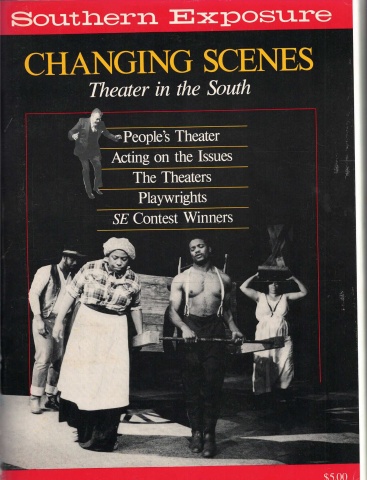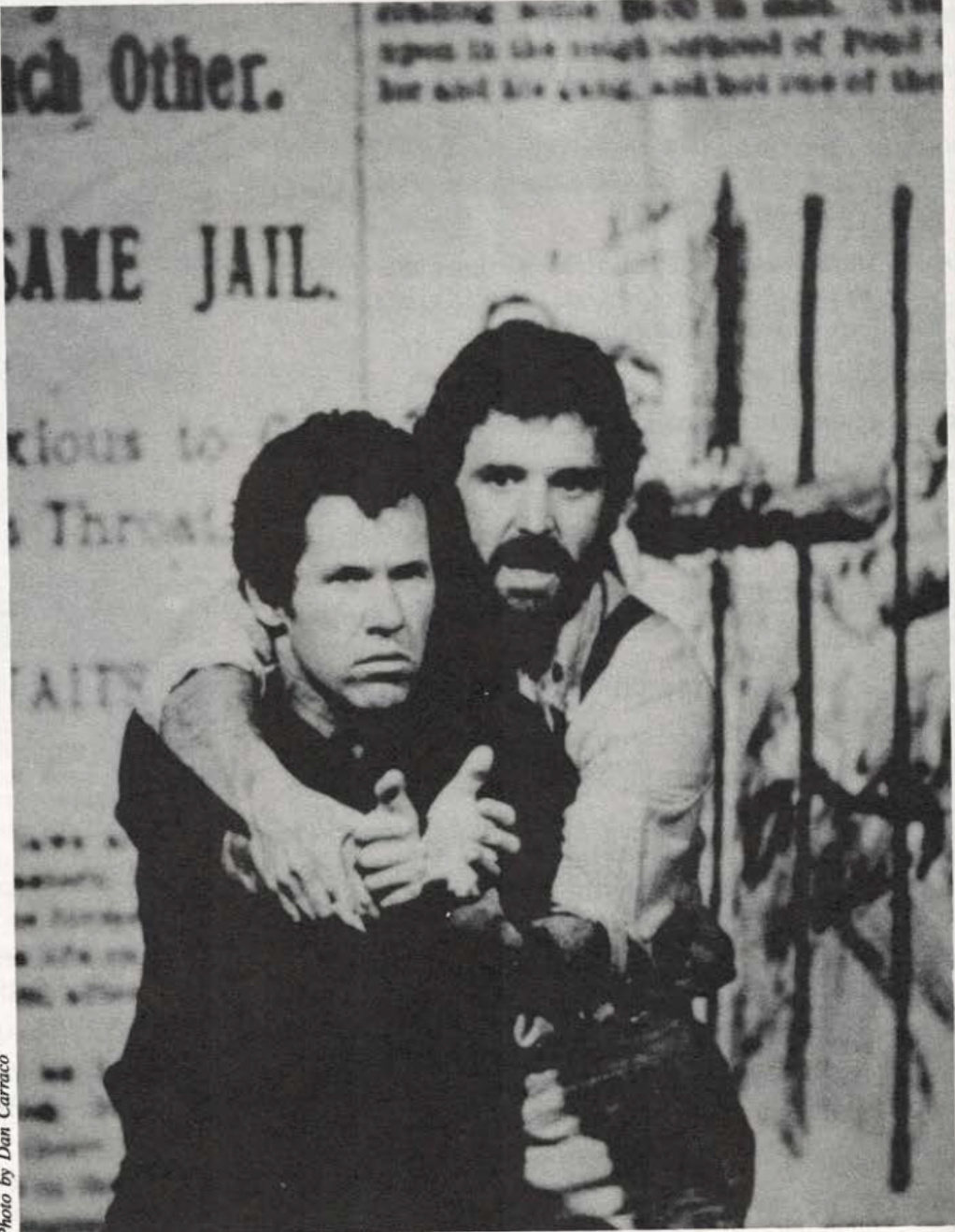
This article originally appeared in Southern Exposure Vol. 14 No. 3/4, "Changing Scenes: Theater in the South." Find more from that issue here.
In 1976 a group of independent storytellers, musicians, and actors gathered at Tennessee's Highlander Center to see what they had in common. Most of them played to an Appalachian audience, and all were interested in developing original work. Dudley Cocke of the Roadside Theater in Kentucky remembers they found that they all shared social and political views which stemmed from coming of age during the civil rights movement and weathering the Vietnam war.
But there was something else. Up to this point, most of these artists had worked in isolated, rural areas. These performing artists shared a common spirit, but struggled alone, unexposed to kindred efforts, and remained vulnerable to the self-doubt that comes with isolation. By coming together, they found not only mutual support, but the very tradition of Southern culture.
They formed Alternate ROOTS, the Regional Organization of Theatres South, dedicated to developing original, indigenous work and to acting as a catalyst for the exchange of art, ideas, and information among its members. The idea was to capitalize on community roots, not to reproduce theater that had its origins elsewhere. In the beginning, says Cocke, "whoever was drawn by this feeling was who we wanted to be there." Since then, ROOTS has grown, and 70 arts organizations and at least as many individuals now participate. Members are spread as far north as Washington, D.C., south to Florida, and west to Louisiana.
ROOTS embraces many performing arts, including theater, mime, juggling, music, storytelling, vaudeville, and dance, as well as performance-oriented writing. But you can't join just by sending in a check. You have to go to one of the meetings or workshops, and you have to bring something worthy of sharing, because ROOTS is an organization where you get out of it what you put into it.
Most of ROOTS' functions are internal. Its major product is a festival held every two years; the next one will be in Atlanta in 1987. The festival is good for publicity, for the audience of course, and for ROOTS members to appreciate one another's finished products. Once every two years, critics and arts writers return to their newspapers with a vision of this other, little-seen America. And they've seen it only because it has gathered together in a large city like Atlanta. The real work is going on out in the sticks, reaching the audience that, by birthright, it belongs to.
The festival, however, is incidental, almost a celebration. ROOTS' major function is networking. This interchange is manifested in regional workshops, annual meetings, a newsletter. And the connections that are made result in collaborations, sharing of resources and skills, mutual criticism and training, more workshops, audience development, touring venues, and just about any way one neighbor can help another. In its simplest sense, probably, ROOTS is about the sharing of information.
At the festival, ROOTS members provide each other with a kind of criticism which they usually don't receive in media reviews. Journalist critics often provide criticism that is limited in its value to performing artists because it is a single opinion and may come from a perspective unaffiliated with the artist's culture. Also, media reviews are often based on a single viewing of a performance and directed primarily to the newspaper's or magazine's readership.
Now, the sort of criticism that goes on at ROOTS meetings — like the one last year in Waco, Georgia — circumvents all these limitations. This is collective criticism, by peers, of works in progress. It's developmental criticism, and it's geared for the artist, not the audience. The performing artists generally need that other point of view in order to discover flaws or alternatives in their art.
John O'Neal of the late Free Southern Theater explains that a ROOTS artist generally doesn't become defensive about peer criticism, because "if you have something larger than yourselves, then you aren't diminished by the critique. You're enlarged by the critique."
The thing that is larger than ROOTS, but which ROOTS participates in, is not too definite. Dudley Cocke characterizes it as a social/political/economic yearning that doesn't disenfranchise the poor, the rural, nor of course the artists. Hence the "alternative" in Alternate ROOTS, not only in an issue-oriented way, but aesthetically as well is a divergence of interest from the opinions handed down by the "tastemakers" who dominate the mainstream media. And, since ROOTS' concerns are regional and community based, that interest might be termed loosely as development of a Southern aesthetic.
What is this Southern aesthetic and where does it come from? First, there's a definite heritage based in folk arts, storytelling, and music. But ROOTS artists don't see their function as curatorial. It's an ongoing tradition, and that's how it differs from the academic approach. There's a strong feeling that culture has evolved more broadly in the South than in other regions of the country.
ROOTS board member M.K. Wegman, of the Contemporary Arts Center in New Orleans, attributes this to an "accident of history." Communities have been more spread out in the South and have existed for a longer time than those in, say, the Middle West, settled a century later. This isolation has promoted self-sufficiency, culturally speaking — a climate where people are more likely to invent their own art.
This last point introduces an ideological debate which currently challenges ROOTS. In networking, in reaching a larger audience, how does ROOTS sustain the "particularity" which is the very life-blood of its constituent art forms? David Steiling, known professionally Dr. Zog, argues that no matter how regionally based an artist is, he or she lives in a time when art can go up to a satellite and come down anywhere. Mass media, of course, threaten to homogenize the arts.
Some of that danger is dissipated by the "particularity" of the art: it can be too local for outsiders to understand. Some ROOTS members learned this important lesson when several toured Europe last year in the Other America Festival. Neither the Roadside Theater of Appalachia, nor John O'Neal's one actor show about a Southern black storyteller connected with audiences. Part of the problem, of course, was the language barrier, and some performers also believed that their culture didn't translate. The shows that did go over well exhibited arcane skills, such as a solo performance of The Tempest.
Nevertheless, the central committee of ROOTS realizes that, as it asserts itself in the international scene, it stands at the threshold of a global community. In a typically ideological discussion, actor John O'Neal explains:
"It's no sooner that we become an American people, that we will be in an even more compelling era, that is, becoming earth people. Already we live in a global economy, and we don't have the political or cultural apparatus to control it. Economically, we're in a state of nature. These lawless, big corporations are running around without anybody telling them, 'You can't do that to people.'"
Growth presents its own problems, which ROOTS perceives as challenges. Ruby Lerner, the group's administrative director for the past several years who came to ROOTS from the Manhattan Theatre Club, is an articulate spokesperson who voices alternative theater's criticism of the process of arts subsidies [See article, p. 9]. Writing last year in American Theatre, she noted that the relationship among arts groups in Atlanta had "deteriorated into a quietly belligerent 'we-they'" situation because of "an enormous amount of support, both public and private, going to three or four organizations and the remaining dozens of small and medium-sized organizations being forced to compete for an inadequate amount of available funding." Acknowledging that the major arts organizations do serve a constituency, she asserts that "they are addressing the cultural needs and tastes of a small minority of the population" in a city with a majority of black people. Further subsidy intended to take mainstream theater to everyday people is a practice "assuming the supremacy of the kind of art produced by these organizations."
More bad news from the private sector — unlike the Northeast or the Midwest, the South doesn't have the tradition of private philanthropy to sustain the small arts groups through the hard times. Nor do the large corporations share the political and economic views of most ROOTS members. Gradually, however, ROOTS is making inroads in the territory of corporate grants. Meanwhile, folks squeeze by, and ROOTS itself survives on an annual budget of $100,000. That, in itself, is astonishing, considering that annual membership dues are $25 per person.
For several years, ROOTS has sought alternatives in theater management, so that marketing doesn't subvert the artistic vision of the member companies. The overall contention is that management should serve the artist, but agreement generally stops there. ROOTS places emphasis on a diversity of management styles and conducts workshops on such subjects as touring and computer skills. The idea is to find what style best fits the company, so that the company doesn't get sucked into the ubiquitous "business model" of management which has prompted so many regional theaters to produce A Christmas Carol each December. Still, there is no all-purpose answer. The emphasis on diversity results in at least one ROOTS member (Academy Theatre, Atlanta) producing A Christmas Carol every December.
Right now, financial concerns are a high priority for the ROOTS administration. It seems to be necessarily so. As David Steiling points out, "You can't separate the financial from the artistic, not if you call yourself a professional artist." The trick, of course, is to make it work for you, instead of against you.
What is "it" anyway? What is art? As futile as it may be to try and answer that question, Roadside's Dudley Cocke says that, in one form or another, it comes up at every ROOTS gathering. They have yet to arrive at a consensus. But, in the process of questioning themselves, they reexamine their art. That's important, especially since the performing arts are so heavily oriented toward process, as opposed to product. So it stands to reason, art may be a process, an act of arriving or coming into being.
Perhaps this portrait of ROOTS has shaped up a shade too ideological. It's hard to imagine a contemporary vaudeville performer asking the question, "What is art?" Then again, maybe not. David Steiling best characterizes ROOTS' members' work as art without the capital A, not that it isn't art, just that it's more accessible. It's the spirit of the art, the sharing, the spiritual high he feels at ROOTS meetings that allows him to return home with recharged batteries. It is also a process of discovery.
Steiling recalls his first encounter with ROOTS: "I walked out into the quadrangle at Vanderbilt University and someone said, 'Stand still.' And I found myself surrounded by three pairs of jugglers, passing 18 clubs in the air at once, going by my face in every direction. It was one of the most elated experiences of my life. And so I became a juggler."
Tags
Tom Boeker
Tom Boeker is an Atlanta theater critic who writes for Open City magazine, Creative Loafing, and Atlanta magazine. (1986)

